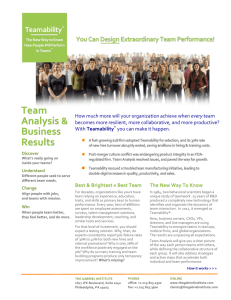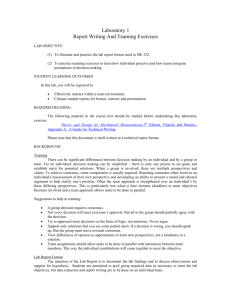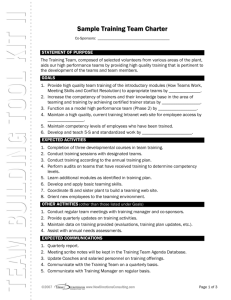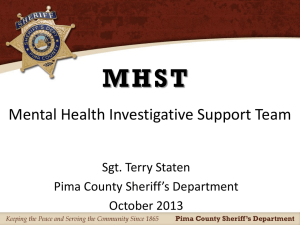Pathways to Wellbeing: Development and Implementation
advertisement
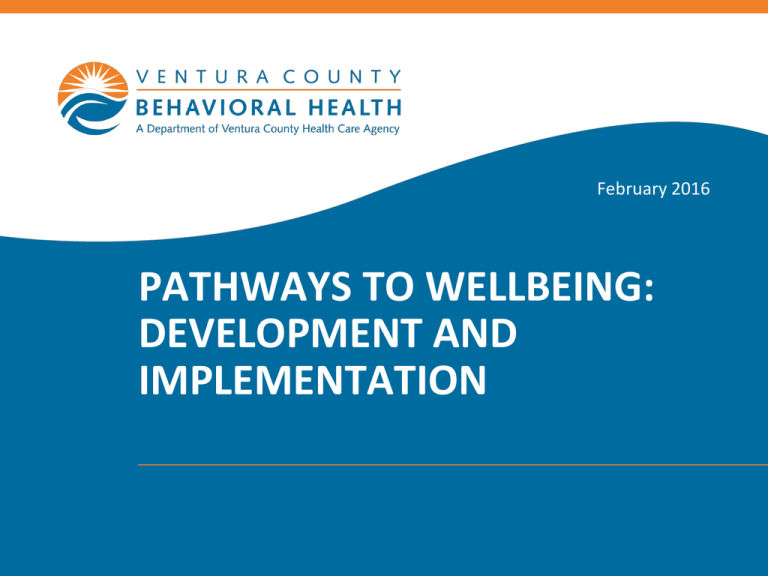
February 2016 PATHWAYS TO WELLBEING: DEVELOPMENT AND IMPLEMENTATION Agenda Coordination efforts in serving the dependency population • Joint Governance: Guides our Efforts • System-wide shift in practice • MHST/Service Delivery Model • Evaluation Frame Work • Continuum Of Care • Building Upon Existing Reform • Next Steps • CFT Development and Implementation 2 Phase One Joint Governance 3 Process Mapping Katie A. Work Flow 4 Initial Data Agreement Identification of shared outcomes • County Counsel involvement for interpretation, i.e. HIPPA • Attempted procedure for sharing of information on Adult, which led to MOU • Changing of Findings and Orders • • Initial identification of shared client population Jointly enrolled Group Home Clients found throughout system 5 Early Katie A. Service Implementation Program Implementation ( 2-year period) • Policy and Procedures Established • MHST Process Agreement • Shift to Universal/Periodic MHSTs 6 MHST Process “Super Staffings” Screening at detention Assessment Team Expanded Services Screen Triage Assess Treatment 7 Universal Mental Health Screening: 961 Initial, Key Event or Rescreening GRAPH 1A: TOTAL SCREENINGS PROVIDED, BY MHST TYPE (n=961)* Initial 140 120 106 20 113 20 20 80 40 Rescreen Blank Total 128 100 60 Key Event 2 6 112 4 82 10 75 112 11 16 88 24 23 30 71 0 11 11 75 56 19 10 120 109 2 9 108 23 27 13 91 14 34 18 24 7 13 21 69 66 49 60 70 40 53 23 0 Jan-15 Feb-15 Mar-15 Apr-15 May-15 Jun-15 Jul-15 Aug-15 Sep-15 Oct-15 Nov-15 Date of MHST / Request for Service 8 MHST: Initial 58%, Key Event 14%, Rescreen 17%(6month) GRAPH 1B: CUMULATIVE SCREENINGS BY TYPE (n=961)* Blank, 126, 11% Rescreen, 186, 17% Initial, 635, 58% Key Event, 155, 14% 9 Age Breakdown: 0-5 43%, 6-11 29%, 12-20 28% GRAPH 2B: CUMULATIVE SCREENINGS BY AGE (n=961)* 18-20, 62, 7% 21+, 3, 0% 0-2, 192, 20% 12-17, 204, 21% 3-5, 223, 23% 6-11, 277, 29% 10 MHST Disposition: Of the 961 67% Newly Accepted or Already Receiving MH Services, 33% No New Case GRAPH 3B: CUMULATIVE SCREENINGS BY DISPOSITION / SERVICE STATUS** (n=961)* In Process, 34, 3% Already Open, 91, 8% In other MH Services, 81, 7% No New Case, 359, 33% GRAPH 4B: NO NEW CASE MADE DUE TO NO REPORTED CONCERNS BY AGE, JAN - NOV 2015 (n=233)* 12 - 17, 17, 7% 18 - 20, 7, 3% 6 - 11, 51, 22% 0 - 2, 88, 38% 3 - 5, 70, 30% Accepted, 531, 49% 68% of No New Case 0-5 11 Total Class Served by Month: 871 Unduplicated GRAPH 7A: TOTAL CLASS AND SUBCLASS MEMBERS IDENTIFIED* (n=871) Class SubClass Total 600 500 400 432 384 439 469 463 505 482 483 493 112 120 126 97 92 105 88 90 344 349 372 371 377 371 373 379 Feb-15 Mar-15 Apr-15 May-15 Jun-15 Jul-15 Aug-15 Sep-15 532 122 516 123 78 300 200 306 410 393 Oct-15 Nov-15 100 0 Jan-15 12 Child Welfare Subsystem Mental Health Services by Age Group 13 Pathways to Wellbeing Implementation Active Joint Management • Executive • Steering • Program • Data: Evaluation Framework Expanded Services • Capacity with Contract Providers • Continuum of Specialized Services • Specialize Assessment Team Embraced Teaming • Joint Staffing • Child & Family Teams • Joint Training of Social Workers and Clinicians • Capturing Teaming 14 Evaluation Framework Data & Evaluation Committee • Utilized Contractor Evalcorp • Guiding Evaluation Questions • Identified Three Domains • Developed Shared language • Goal: to collect meaningful data • First look at data reports • Evaluation Framework melded our understanding which lead to definition of joint outcomes Three Primary Evaluation Domains 15 Guiding Evaluation Questions 16 Moving from Silos to a Managed System 17 3 Primary Evaluation Domains 18 Current Evaluation Metrics 19 Domain I: Impact on Children/Youth 20 Domain I: Impact on Children/Youth 21 Domain I: Impact on Children/Youth 22 Domain I: Impact on Children/Youth 23 Domain II: Impact on Family/Caregivers 24 Domain III: HCA/HSA Collaboration 25 Long Term Goals for Data Infrastructure 26 Next Steps: Continuum of Care Reform AB 403 • Pathways to Wellbeing is viewed as part of a broad reform strategy with our HSA partners • We are embracing a bigger vision and need to expand Joint Governance • Focused on continued Teaming and heightened Care Coordination • Moving from program planning to system-wide access and treatment in a home-like setting • Moving toward TOP Assessment Tool to jointly help determine mental health needs and appropriate placements 27 CCR Building on Current Efforts Behavioral Health Child Welfare VCBH Continuum of Mental Health Care Approved Relative Caregivers Program Resource Family Approval Program Quality Parenting Initiative Child and Family Teaming (Core Practice Model) Pathways to Wellbeing Family Preservation Safety Organized Practice Prevention Wellness and Recovery Assessment and Early Intervention Treatment Residential & Acute Care Trauma Informed Care Evidence Based Practice Pathways to Wellbeing Multidisciplinary Treatment Planning/Child and Family Teaming 28 Continuum of Care Reform: first look September 2014 September 2015 Children in care 926 884 Children in congregate care 95 84 Length of stay in care 18 months or longer 39.8% 44.6% Re-entry into care within 12 months following reunification 10.2% 7.5% Relative / family friend placements 38.2% 45.4% Reunification within 12 months (entry cohort) 46.6% 40.7% 51% 43.9% Desired Result Exit to permanency within 12 months 29 Ventura County Child Welfare Placements Ventura Child Welfare Placement Data on 1/1/16 Facility Type Casa - Shelter Court Specified Home Foster Family Agency Certified Home Foster Family Home Group Home Guardian Home Relative/NREFM Home Small Family Home Supervised Independent Living Placement Of those in Group Homes plus the Shelter: Child Count 21 9 94 129 53 106 468 8 28 916 % 2.29% 0.98% 10.26% 14.08% 5.79% 11.57% 51.09% 0.87% 3.06% 100% Age 0-5 0 Age 6-11 11 Age 12-17 59 Age 18+ 4 Slide provided by the Human Service Agency 30 Bi-Annual Group Home Placement Data (per Safe Measures, 18 month cycle) Jul ’15 – Dec ‘15 Casa Pacifica (Shelter & RTC) In-County Group Home Out of County Group Home County not Specified TOTAL July 2015 28 36 18 3 85 August 2015 25 28 20 2 75 September 2015 33 27 21 3 84 October 2015 36 26 20 3 85 November 2015 27 27 21 4 74 December 2015 25 25 20 4 74 AVERAGE 29% 28.16% 20% 3.16% 80.33% Slide provided by the Human Service Agency 31 Group Home Services VCBH Quality Improvement Project • Small amount of Group Home youth receiving medication services at outpatient clinics • Need for heightened coordination of care • VCBH faces the challenge of the development of the Short-term Residential Treatment Centers (ST-RTC) 32 CCR: Development of Short-Term Residential Treatment Center(STRTC) • STRTC will seek licensure and demonstrate capacity to meet treatment level needs • Will ensure a quick transition to home-based family placement • Foster Family Agencies(FFA) and STRTC will deliver an array of “core services” • Mental Health in home-based family care regardless of placement setting • FFA and STRTC will be certified by the county MH Plan or arrange for Specialty MH Services • Standardize Assessment Process to coordinate Child Welfare & Behavioral Health services • STRTC and FFA will require accreditation • Development of a coordinated monitoring and oversight system between California Department of Social Services and Department of Health Care Services 33 Our Goals…Challenges…Opportunities Continuum of Care Reform: AB 403 LegislatiContinuum of Care Reform: AB 403 Expand efforts to Legislation n Enhance the level ensure Mental Heath services meet the treatment needs of child/youth regardless of the placement of integration among Child Welfare and County Mental Health Expand availability of specialized Mental Health services in a homebased setting 34 CFT DEVELOPMENT AND IMPLEMENTATION CFT Development and Implementation Created Pilot to Develop Model • Teams of SW and Clinician in specific geographic areas • Issues and Challenges Facilitation Discomfort Training Needed on Facilitation Skills Logistics (family, scheduling and location) Developed Kaizen • Goal: Establish Policies and Procedures • Workgroup included: Family, Parent Partners, HSA, BHD, Public Health, Foster and Biological Parents, Youth Representatives • Scheduled Cross-System Training with focus on: 1. Shifting Paradigm 2. Developing Teaming Approach 3. Training on Facilitation Strategies 36 Challenges and CCR HSA Challenge: • Consistent documentation • How would this occur – Protocol from CMS/CWS • Preliminary Data Results CCR Shifting Approach • Teaming Model vs. CFT ‘Centric’ • Challenge in Scheduling and Coordination • Expanding Teaming (Family Meetings) approach across the entire Foster System 37 Training • • • • • Multiple/ongoing Training Scheduled Small Groups with HSA and BHD staff “Teaming Model” Two Training Components: Overview of CFT Philosophy Facilitation Model Focus on Skill Building Lessons Learned: Works best in TDM “like” model (trained in facilitation model) IHBS/Wraparound better suited to acting as facilitator Future: Facilitator as a unique position; shift in facilitation 38 Thank you for listening 39
